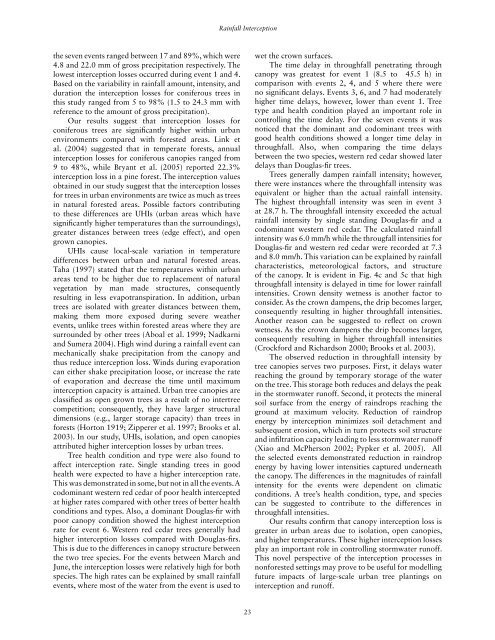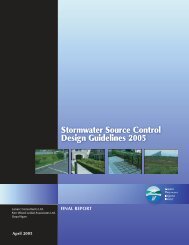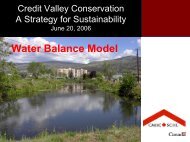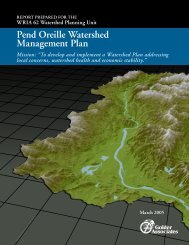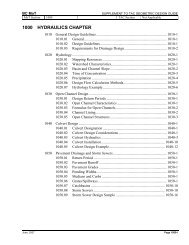A New Approach in Measuring Rainfall Interception by Urban Trees ...
A New Approach in Measuring Rainfall Interception by Urban Trees ...
A New Approach in Measuring Rainfall Interception by Urban Trees ...
Create successful ePaper yourself
Turn your PDF publications into a flip-book with our unique Google optimized e-Paper software.
Ra<strong>in</strong>fall <strong>Interception</strong><br />
the seven events ranged between 17 and 89%, which were<br />
4.8 and 22.0 mm of gross precipitation respectively. The<br />
lowest <strong>in</strong>terception losses occurred dur<strong>in</strong>g event 1 and 4.<br />
Based on the variability <strong>in</strong> ra<strong>in</strong>fall amount, <strong>in</strong>tensity, and<br />
duration the <strong>in</strong>terception losses for coniferous trees <strong>in</strong><br />
this study ranged from 5 to 98% (1.5 to 24.3 mm with<br />
reference to the amount of gross precipitation).<br />
Our results suggest that <strong>in</strong>terception losses for<br />
coniferous trees are significantly higher with<strong>in</strong> urban<br />
environments compared with forested areas. L<strong>in</strong>k et<br />
al. (2004) suggested that <strong>in</strong> temperate forests, annual<br />
<strong>in</strong>terception losses for coniferous canopies ranged from<br />
9 to 48%, while Bryant et al. (2005) reported 22.3%<br />
<strong>in</strong>terception loss <strong>in</strong> a p<strong>in</strong>e forest. The <strong>in</strong>terception values<br />
obta<strong>in</strong>ed <strong>in</strong> our study suggest that the <strong>in</strong>terception losses<br />
for trees <strong>in</strong> urban environments are twice as much as trees<br />
<strong>in</strong> natural forested areas. Possible factors contribut<strong>in</strong>g<br />
to these differences are UHIs (urban areas which have<br />
significantly higher temperatures than the surround<strong>in</strong>gs),<br />
greater distances between trees (edge effect), and open<br />
grown canopies.<br />
UHIs cause local-scale variation <strong>in</strong> temperature<br />
differences between urban and natural forested areas.<br />
Taha (1997) stated that the temperatures with<strong>in</strong> urban<br />
areas tend to be higher due to replacement of natural<br />
vegetation <strong>by</strong> man made structures, consequently<br />
result<strong>in</strong>g <strong>in</strong> less evapotranspiration. In addition, urban<br />
trees are isolated with greater distances between them,<br />
mak<strong>in</strong>g them more exposed dur<strong>in</strong>g severe weather<br />
events, unlike trees with<strong>in</strong> forested areas where they are<br />
surrounded <strong>by</strong> other trees (Aboal et al. 1999; Nadkarni<br />
and Sumera 2004). High w<strong>in</strong>d dur<strong>in</strong>g a ra<strong>in</strong>fall event can<br />
mechanically shake precipitation from the canopy and<br />
thus reduce <strong>in</strong>terception loss. W<strong>in</strong>ds dur<strong>in</strong>g evaporation<br />
can either shake precipitation loose, or <strong>in</strong>crease the rate<br />
of evaporation and decrease the time until maximum<br />
<strong>in</strong>terception capacity is atta<strong>in</strong>ed. <strong>Urban</strong> tree canopies are<br />
classified as open grown trees as a result of no <strong>in</strong>tertree<br />
competition; consequently, they have larger structural<br />
dimensions (e.g., larger storage capacity) than trees <strong>in</strong><br />
forests (Horton 1919; Zipperer et al. 1997; Brooks et al.<br />
2003). In our study, UHIs, isolation, and open canopies<br />
attributed higher <strong>in</strong>terception losses <strong>by</strong> urban trees.<br />
Tree health condition and type were also found to<br />
affect <strong>in</strong>terception rate. S<strong>in</strong>gle stand<strong>in</strong>g trees <strong>in</strong> good<br />
health were expected to have a higher <strong>in</strong>terception rate.<br />
This was demonstrated <strong>in</strong> some, but not <strong>in</strong> all the events. A<br />
codom<strong>in</strong>ant western red cedar of poor health <strong>in</strong>tercepted<br />
at higher rates compared with other trees of better health<br />
conditions and types. Also, a dom<strong>in</strong>ant Douglas-fir with<br />
poor canopy condition showed the highest <strong>in</strong>terception<br />
rate for event 6. Western red cedar trees generally had<br />
higher <strong>in</strong>terception losses compared with Douglas-firs.<br />
This is due to the differences <strong>in</strong> canopy structure between<br />
the two tree species. For the events between March and<br />
June, the <strong>in</strong>terception losses were relatively high for both<br />
species. The high rates can be expla<strong>in</strong>ed <strong>by</strong> small ra<strong>in</strong>fall<br />
events, where most of the water from the event is used to<br />
wet the crown surfaces.<br />
The time delay <strong>in</strong> throughfall penetrat<strong>in</strong>g through<br />
canopy was greatest for event 1 (8.5 to 45.5 h) <strong>in</strong><br />
comparison with events 2, 4, and 5 where there were<br />
no significant delays. Events 3, 6, and 7 had moderately<br />
higher time delays, however, lower than event 1. Tree<br />
type and health condition played an important role <strong>in</strong><br />
controll<strong>in</strong>g the time delay. For the seven events it was<br />
noticed that the dom<strong>in</strong>ant and codom<strong>in</strong>ant trees with<br />
good health conditions showed a longer time delay <strong>in</strong><br />
throughfall. Also, when compar<strong>in</strong>g the time delays<br />
between the two species, western red cedar showed later<br />
delays than Douglas-fir trees.<br />
<strong>Trees</strong> generally dampen ra<strong>in</strong>fall <strong>in</strong>tensity; however,<br />
there were <strong>in</strong>stances where the throughfall <strong>in</strong>tensity was<br />
equivalent or higher than the actual ra<strong>in</strong>fall <strong>in</strong>tensity.<br />
The highest throughfall <strong>in</strong>tensity was seen <strong>in</strong> event 3<br />
at 28.7 h. The throughfall <strong>in</strong>tensity exceeded the actual<br />
ra<strong>in</strong>fall <strong>in</strong>tensity <strong>by</strong> s<strong>in</strong>gle stand<strong>in</strong>g Douglas-fir and a<br />
codom<strong>in</strong>ant western red cedar. The calculated ra<strong>in</strong>fall<br />
<strong>in</strong>tensity was 6.0 mm/h while the througfall <strong>in</strong>tensities for<br />
Douglas-fir and western red cedar were recorded at 7.3<br />
and 8.0 mm/h. This variation can be expla<strong>in</strong>ed <strong>by</strong> ra<strong>in</strong>fall<br />
characteristics, meteorological factors, and structure<br />
of the canopy. It is evident <strong>in</strong> Fig. 4c and 5c that high<br />
throughfall <strong>in</strong>tensity is delayed <strong>in</strong> time for lower ra<strong>in</strong>fall<br />
<strong>in</strong>tensities. Crown density wetness is another factor to<br />
consider. As the crown dampens, the drip becomes larger,<br />
consequently result<strong>in</strong>g <strong>in</strong> higher throughfall <strong>in</strong>tensities.<br />
Another reason can be suggested to reflect on crown<br />
wetness. As the crown dampens the drip becomes larger,<br />
consequently result<strong>in</strong>g <strong>in</strong> higher throughfall <strong>in</strong>tensities<br />
(Crockford and Richardson 2000; Brooks et al. 2003).<br />
The observed reduction <strong>in</strong> throughfall <strong>in</strong>tensity <strong>by</strong><br />
tree canopies serves two purposes. First, it delays water<br />
reach<strong>in</strong>g the ground <strong>by</strong> temporary storage of the water<br />
on the tree. This storage both reduces and delays the peak<br />
<strong>in</strong> the stormwater runoff. Second, it protects the m<strong>in</strong>eral<br />
soil surface from the energy of ra<strong>in</strong>drops reach<strong>in</strong>g the<br />
ground at maximum velocity. Reduction of ra<strong>in</strong>drop<br />
energy <strong>by</strong> <strong>in</strong>terception m<strong>in</strong>imizes soil detachment and<br />
subsequent erosion, which <strong>in</strong> turn protects soil structure<br />
and <strong>in</strong>filtration capacity lead<strong>in</strong>g to less stormwater runoff<br />
(Xiao and McPherson 2002; Pypker et al. 2005). All<br />
the selected events demonstrated reduction <strong>in</strong> ra<strong>in</strong>drop<br />
energy <strong>by</strong> hav<strong>in</strong>g lower <strong>in</strong>tensities captured underneath<br />
the canopy. The differences <strong>in</strong> the magnitudes of ra<strong>in</strong>fall<br />
<strong>in</strong>tensity for the events were dependent on climatic<br />
conditions. A tree’s health condition, type, and species<br />
can be suggested to contribute to the differences <strong>in</strong><br />
throughfall <strong>in</strong>tensities.<br />
Our results confirm that canopy <strong>in</strong>terception loss is<br />
greater <strong>in</strong> urban areas due to isolation, open canopies,<br />
and higher temperatures. These higher <strong>in</strong>terception losses<br />
play an important role <strong>in</strong> controll<strong>in</strong>g stormwater runoff.<br />
This novel perspective of the <strong>in</strong>terception processes <strong>in</strong><br />
nonforested sett<strong>in</strong>gs may prove to be useful for modell<strong>in</strong>g<br />
future impacts of large-scale urban tree plant<strong>in</strong>gs on<br />
<strong>in</strong>terception and runoff.<br />
23


